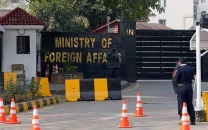Gallows oiled: Steps away from hangman’s noose
Preparations complete for first civilian executions in five years.

A plaque at the entrance bears details of the last execution that took place in the jail. PHOTO: RABIA ALI/EXPRESS
For more than a year, convict Behram Khan has cheated death. However, by next Wednesday, if no stay order is issued, he will only be eight wooden steps away from the hangman’s noose.
With the end of the Pakistan Peoples Party-led government, two executions have been lined up for August 21 and 22 in Central Prison, Karachi. Outgoing president Asif Ali Zardari had been taking stay orders during his tenure after black warrants were issued for convicts. If the scheduled hangings of Behram Khan and Shafqat Hussain take place, they would be the first executions of civilian prisoners since February 2008 – which was when the PPP government took office.
Preparations for the executions have begun. Inmates and jail officers of the Central Prison, Karachi, are busy oiling and scrubbing the gallows and its staircase.
In the phansi ghaat, a secluded place in the prison for executions, an inmate’s hands trembled as he brushed oil over the latch of the gigantic gallows, giving it a gleaming look. “I keep on thinking about how the doors will open and a man would hang lifelessly.”
The black gallows made of metal and wood has been used for hangings since the British established the jail in 1899. Since the country’s independence, the gallows has witnessed 57 executions.
With no stay order or mercy, Behram, who killed a lawyer in 2003, would be the first to walk the gallows on Wednesday morning. Shafqat Hussain, who kidnapped and killed a seven-year-old boy, is to be hanged on Thursday.
Officers made sure that the execution place – covered with mud and dust – was being cleaned thoroughly. Around the gallows, inmates and labourers removed the muck that had accumulated because of the rains. Near the entrance of the phansi ghaat, marked with a plaque with details of the last execution, jailer Shahab directed his men to cover the open drains. “Cover them with slabs,” he said to other jail officers.
On execution day, only jail officials, a magistrate and a doctor would be able to enter the phansi ghaat.
Even seconds before the hanging, an inmate’s execution can be put off. “In the olden days, our officer would sit next to the telephone in case the head of the state ordered a stay, but now with mobile phones, we can instantly get a phone call about the president’s order.”
The hangman’s knot
Jail officials have also started preparing the hangman’s noose. The death noose is made differently for every prisoner, depending on his weight. A jail officer said ropes were first made by the inmates only but they are now bought from markets.
Before execution day, the jail officers carry out a trial hanging with a sandbag, where the noose is made to carry more weight than required, to test the noose.
Three knots are prepared for each condemned prisoner; two of them are kept in spare. According to the jailer, since the executions have not been held in the jail for years, previous hangmen have retired, and the hangman who will lead the upcoming execution will come from other prison in Sindh.
Published in The Express Tribune, August 16th, 2013.



















COMMENTS
Comments are moderated and generally will be posted if they are on-topic and not abusive.
For more information, please see our Comments FAQ